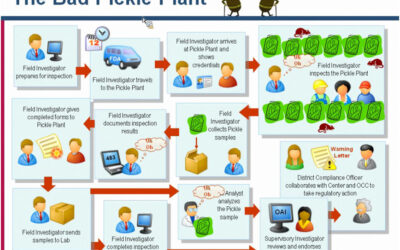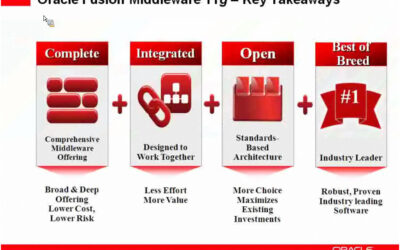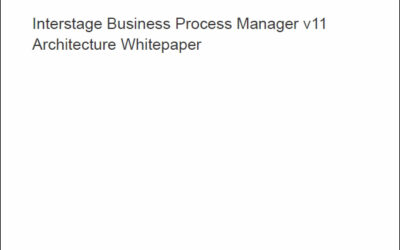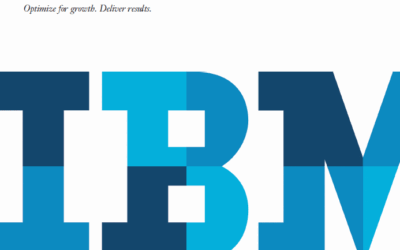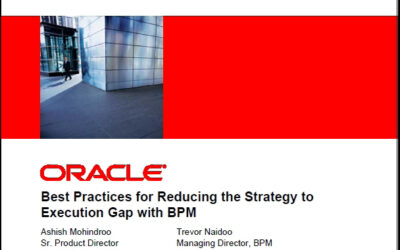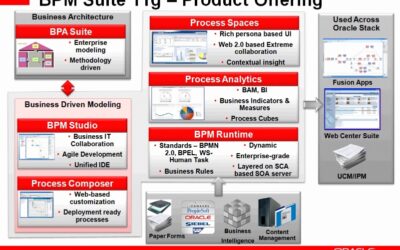Governments and companies worldwide have for generations sought to better manage the processes that are key to their constituencies and business by managing them to improve efficiency, insight into their impact, and how to use them to achieve greater flexibility. Over the years the introduction of new technology provides new ways to achieve these benefits yet each new technology also imposes a barrier in the path of success. In addition, change management and human and organizational change is a naturally resistant force that can stand in the way of success.
Articles by: BPMInstitute.org
BPM for Government Demo
This webcast will give participants hands-on exposure to Business Process Management with the Oracle BPM Suite and will show how Oracle BPM Suite can be used across each phase of the BPM lifecycle to help government agencies achieve continuous process improvement. This workshop webcast will demonstrate process modeling, process improvement, process implementation, process interaction and process monitoring using a government specific use-case of construction/building permit processing across various roles and systems.
Interstage Business Process Manager v11 Architecture
Interstage BPM advanced architecture flexibly addresses requirements of the next generation BPM to effectively manage work in today’s enterprise. Broad array of capabilities enables organizations to respond to business change by supporting all types of business processes and all forms of work.
Research indicates that the use of BPM technology can lead to remarkable cost savings, increased efficiency, and productivity – in other words, big ROI. Enterprises and software developers have come to understand that BPM can be applied to increasingly complex problems. Automating business processes from end-to-end, integrating applications to process steps, and opening up processes for collaboration with partners, customers, and suppliers represent just the beginning of what can be expected from BPM software.
Distributed Architecture of Enterprise Information Systems
According to AIIM & Accenture Surveys report – in the next few years’ volume of information produced by our civilization will be doubled. Report also points, that arrangement will be split into 20% of structured data and 80% of unstructured data. Following this analysis, Gartner (Feb 2008) points that “By 2009 ECMs will become the focal point for empowered managers, enabling proactive or reactive responses to opportunity and threat scenarios”.
Process Improvement – Patterns for Success
Explore the many ways IBMs Business Process Management and Decision Management technologies enable agility through dynamic business processes. Use-cases describe approaches for using these technologies individually or together to address different business needs. Process improvement is about achieving better business outcomes. Technology is providing powerful capabilities that organizations are using now to quickly and continuously improve customer-facing and back-end operations. The challenge, of course, is that there is no one-size-fits-all solution.
Best Habits for Highly Successful BPM Programs
Learn the Habits that drive process-improvement success, from project delivery and growing team competency to scaling BPM across the enterprise. These are proven techniques that will help you get started implementing successful BPM projects throughout your organization. Process improvement is about achieving better business outcomes. Technology is providing powerful capabilities that organizations are using now to quickly and continuously improve customer-facing and back-end operations. The challenge, of course, is that there is no one-size-fits-all solution.
Business Agility Realized
On a smarter planet, change, complexity and uncertainty have become opportunities for businesses and entire industries to transform, grow and serve customers in new ways. This reality is driven by three shifts:
Driving The Top Line: Beyond Efficiency And Quality
Although “doing more with less” is a common mantra these days, delivering improved business efficiency is necessary, but not sufficient, to put organisations in strong competitive positions. Business change velocity, combined with increasingly stringent customer expectations, mean that agility and responsiveness have to be equally important goals for business improvement projects. Business Process Management (BPM) – the business improvement approach that.s naturally aligned to address end-to-end improvements – needs to be part of your business improvement toolkit here. But if a BPM initiative is going to help you drive top-line growth, you.re going to need to think differently and employ additional functionality.
This report explores how organisations can build on a foundation of process automation for operational agility and responsiveness, by enlisting complementary technologies like business event processing and business rules management.
Best Practices and Customer Success with BPM
Dan discusses BPM success stories and resulting best practices from recent implementations.
Product Demonstration Oracle BPM Suite 11g
An overview of the aspects of BPM Suite 11g and a thorough look at the latest process management technology from Oracle that is being designed to simplify achieving process management success.
